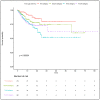Plasma Anion Gap and Risk of In-Hospital Mortality in Patients with Acute Ischemic Stroke: Analysis from the MIMIC-IV Database
- PMID: 34683145
- PMCID: PMC8541378
- DOI: 10.3390/jpm11101004
Plasma Anion Gap and Risk of In-Hospital Mortality in Patients with Acute Ischemic Stroke: Analysis from the MIMIC-IV Database
Abstract
We aimed to investigate the association between the plasma anion gap (AG) and in-hospital mortality among patients with acute ischemic stroke (AIS). In total, 1236 AIS patients were enrolled using the Medical Information Mart for Intensive Care Database IV. Primary outcome was in-hospital mortality. The patients were divided into four groups according to AG category. The mean age and Charlson comorbidity index increased as the AG category increased. The fourth AG category was most related to the in-hospital mortality (hazards ratio (HR), 95% confidence interval (CI): 2.77, 1.60-4.71), even after adjusting for possible confounding variables (Model 1: HR, 95% CI: 3.37, 1.81-6.09; Model 2: HR, 95% CI: 3.57, 1.91-6.69). Moreover, intensive care unit mortality (p = 0.008) was higher in the highest AG category, but the intracranial hemorrhage (p = 0.071) did not associate with the plasma AG. The plasma AG had a satisfactory predictive ability for in-hospital mortality among AIS patients (areas under the receiver operating characteristic curve: 0.631). The plasma AG is an independent risk factor that can satisfactorily predict the in-hospital mortality among AIS patients.
Keywords: MIMIC-IV; anion gap; intensive care unit; ischemic stroke.
Conflict of interest statement
The authors declare no conflict of interest.
Figures




References
-
- Krishnamurthi R.V., Ikeda T., Feigin V.L. Global, Regional and Country-Specific Burden of Ischaemic Stroke, Intracerebral Haemorrhage and Subarachnoid Haemorrhage: A Systematic Analysis of the Global Burden of Disease Study 2017. Neuroepidemiology. 2020;54:171–179. doi: 10.1159/000506396. - DOI - PubMed
Grants and funding
LinkOut - more resources
Full Text Sources
Miscellaneous

